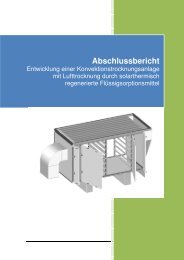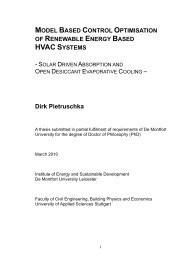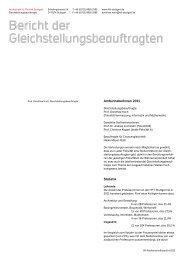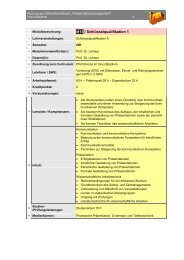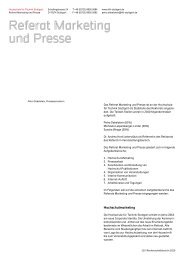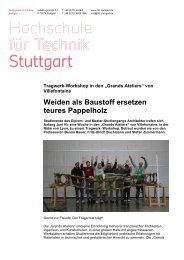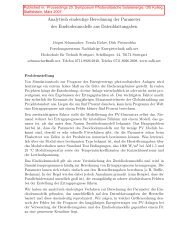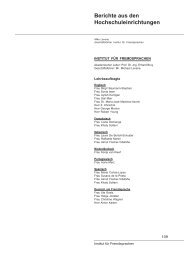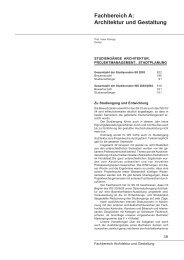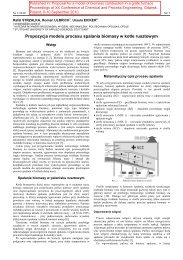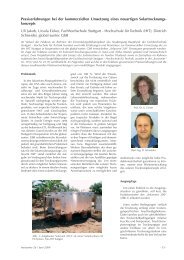experimental investigation of bubble pump and system - HFT Stuttgart
experimental investigation of bubble pump and system - HFT Stuttgart
experimental investigation of bubble pump and system - HFT Stuttgart
Create successful ePaper yourself
Turn your PDF publications into a flip-book with our unique Google optimized e-Paper software.
Heat SET 2007<br />
Heat Transfer in Components <strong>and</strong> Systems<br />
for Sustainable Energy Technologies<br />
18-20 April 2007, Chambery, France<br />
EXPERIMENTAL INVESTIGATION OF BUBBLE PUMP<br />
AND SYSTEM PERFORMANCE FOR A SOLAR DRIVEN<br />
2.5 KW DIFFUSION ABSORPTION COOLING MACHINE<br />
Uli Jakob 1 , Ursula Eicker 2 , Dietrich Schneider 2 , Alex<strong>and</strong>er Teußer 2<br />
1 SolarNext AG, Nordstraße 10, D-83253 Rimsting, Germany<br />
uli.jakob@solarnext.de<br />
2 Centre for Applied Research <strong>of</strong> Sustainable Energy Technology - zafh.net<br />
University <strong>of</strong> Applied Sciences, Schellingstraße 24, D-70174 <strong>Stuttgart</strong>, Germany<br />
eicker@zafh.net<br />
ABSTRACT<br />
This paper presents the development <strong>and</strong> <strong>experimental</strong> <strong>investigation</strong> <strong>of</strong> the indirectly heated,<br />
solar powered generator with its <strong>bubble</strong> <strong>pump</strong> <strong>and</strong> the 2.5 kW Diffusion Absorption Cooling<br />
Machine (DACM) performance. The DACM, which has a combined evaporator-gas heat<br />
exchanger-absorber unit, is designed for the application area <strong>of</strong> air-conditioning as a water<br />
chiller as well as for the operation <strong>of</strong> activated ceilings with an evaporator temperature <strong>of</strong><br />
12/6°C or 18/15°C, respectively. The set up <strong>of</strong> the machine with two different <strong>bubble</strong> <strong>pump</strong>s<br />
was in October 2005. With a total height <strong>of</strong> 2.20 m <strong>and</strong> a weight <strong>of</strong> 240 kg marketable<br />
dimensions were reached. The measurements were carried out at stationary pressure <strong>and</strong><br />
temperature levels. Heating temperatures <strong>of</strong> the generator in a range between 100°C <strong>and</strong><br />
150°C were obtained. The values <strong>of</strong> coefficient <strong>of</strong> performance (COP) were between 0.12 <strong>and</strong><br />
0.38, while the continuous evaporator cooling performance was between 0.7 kW <strong>and</strong> 3.0 kW,<br />
depending on cold cycle temperatures (-8 to +18°C). In October 2006, the two <strong>bubble</strong> <strong>pump</strong>s<br />
were replaced by a single one, which now combines the heat transfer surfaces <strong>of</strong> the two<br />
previous <strong>bubble</strong> <strong>pump</strong>s. The latest performance <strong>of</strong> the machine showed cooling capacities <strong>of</strong><br />
2.0 kW <strong>and</strong> 2.4 kW at evaporator inlet/outlet temperatures <strong>of</strong> 12/6°C <strong>and</strong> 18/15°C,<br />
respectively. The average COPs are 0.3 at heating inlet temperatures <strong>of</strong> 125°C. The<br />
performance <strong>of</strong> the investigated <strong>bubble</strong> <strong>pump</strong>s shows that they work in a wide operation<br />
range at varied heating temperatures as well as external mass flows.<br />
INTRODUCTION<br />
In the last years, the air-conditioning market has been continuously exp<strong>and</strong>ing. The units that<br />
dominate the market are the small split-units with a cooling capacity <strong>of</strong> around 2 kW up to 4<br />
kW. Due to the large number <strong>of</strong> manufactured units, these <strong>system</strong>s are produced <strong>and</strong> <strong>of</strong>fered<br />
at very low prices; however, such <strong>system</strong>s increase the adverse effects on local environments<br />
by using primary energy such as electricity.
2<br />
Over the years, some prototypes <strong>of</strong> commercial absorption refrigerators with indirectly solar<br />
powered generators have been <strong>experimental</strong>ly <strong>and</strong> theoretically investigated. In these studies,<br />
COPs <strong>of</strong> 0.2 to 0.3 <strong>and</strong> cooling capacities between 16 W <strong>and</strong> 62 W were reached at heating<br />
temperatures between 160°C <strong>and</strong> 230°C <strong>and</strong> evaporator temperatures <strong>of</strong> -6°C down to -18°C<br />
(Keizer, 1979; Bourseau et al., 1987; Gutiérrez, 1988; Ajib et al., 1998). One research group<br />
used a Diffusion Absorption Heat Pump (DAHP), which is not yet commercially available,<br />
<strong>and</strong> modified it by substituting the direct gas fired generator by an indirectly heated generator<br />
(Braun et al., 2002; Stürzebecher et al., 2004). The solar thermal heating capacity <strong>of</strong> 1.8 kW<br />
is provided by vacuum tube collectors. The cooling capacity is approximately 1 kW <strong>and</strong> the<br />
COP is given with 0.59 at a heating temperature <strong>of</strong> 175°C <strong>and</strong> an evaporator temperature <strong>of</strong><br />
2°C.<br />
Considering the circumstances that no suitable thermally driven cooling machines with smallscale<br />
cooling performance (1 kW to 5 kW) are available on the market, the <strong>Stuttgart</strong><br />
University <strong>of</strong> Applied Sciences has developed <strong>and</strong> set up three single-effect ammonia/water<br />
DACM (Jakob et al., 2002; Jakob, 2005; Jakob et al., 2005). The design cooling capacity <strong>of</strong><br />
the machine is 2.5 kW for buildings <strong>and</strong> residential air-conditioning applications.<br />
PROTOTYPE DESIGN<br />
The well-known diffusion absorption technique which was developed in the 1920s by the<br />
Swedish engineers von Platen <strong>and</strong> Munters (Niebergall, 1981) is based on the principle <strong>of</strong><br />
pressure equilibration between the high <strong>and</strong> low ammonia partial pressure sides <strong>of</strong> the unit<br />
through an inert auxiliary gas. A further peculiarity <strong>of</strong> this type <strong>of</strong> absorption cooling machine<br />
is the use <strong>of</strong> an indirectly driven <strong>bubble</strong> <strong>pump</strong> for the circulation <strong>of</strong> the solution cycle, instead<br />
<strong>of</strong> the mechanical solution <strong>pump</strong>, so that inside the cooling machine no mechanically moving<br />
parts are necessary.<br />
Fig. 1: DACM prototype (photo: zafh.net)
3<br />
Figure 1 shows the developed DACM, which consists <strong>of</strong> a generator, a condenser, a combined<br />
evaporator-gas heat exchanger (GHX)-absorber unit, a solution heat exchanger (SHX) in the<br />
solution circuit as well as a dephlegmator for the condensation <strong>of</strong> the evaporated solvent.<br />
These components are vertical steel tubular heat exchangers or nickel soldered plate <strong>and</strong><br />
stainless steel coaxial heat exchangers, which are hermetically tight welded. One special<br />
feature is the recirculation <strong>of</strong> the condensed solvent from the dephlegmator into the rich<br />
solution before the generator inlet <strong>and</strong> not as usually into the weak solution at the top <strong>of</strong> the<br />
generator outlet. Simulations have shown (Teußer, 2004), that the runback has a higher<br />
ammonia concentration than the rich solution, so that it is better to supply the condensed<br />
solvent to the generator inlet instead to the absorber inlet. The constructive solution for this<br />
kind <strong>of</strong> runback is the so-called Jakob-Teußer-bend. The used working pair for the solution<br />
circulation is an ammonia/water mixture. The inert auxiliary gas used is helium. The DACM<br />
is designed for the application area <strong>of</strong> air-conditioning as water chiller with an evaporator<br />
temperature <strong>of</strong> 12/6°C as well as for the operation <strong>of</strong> cooled ceilings with an evaporator<br />
temperature <strong>of</strong> 18/15°C. The third prototype weighs 240 kg <strong>and</strong> has a total height <strong>of</strong> 2.20 m.<br />
METHOD OF ANALYSIS<br />
The components <strong>of</strong> the DACM with its <strong>bubble</strong> <strong>pump</strong> were investigated with Pt100 resistance<br />
temperature sensors. The volume flow rates <strong>of</strong> the external heating <strong>and</strong> cooling cycles were<br />
measured by miniature turbine, magnetic inductive <strong>and</strong> suspended flow meters. Up to now<br />
there were no suitable measurement devices for the internal weak or rich solution volume<br />
flow available, which could measure very low volume flows inside the tubes <strong>and</strong> has no high<br />
pressure losses. Now with the latest magnetic inductive flow meter the weak solution flow<br />
could be measured. The capacities are determined out <strong>of</strong> the temperature difference from the<br />
inlet <strong>and</strong> outlet as well as from the volume flow measurement. The COP is defined as ratio<br />
between the determined evaporator cooling capacity <strong>and</strong> the generator heating input. For the<br />
<strong>bubble</strong> <strong>pump</strong> characteristic the ammonia vapour mass flow is determined out <strong>of</strong> the measured<br />
condenser cooling capacity <strong>and</strong> with that the calculated ammonia condensate, respectively.<br />
EXPERIMENTAL RESULTS<br />
The set up <strong>of</strong> the machine with two different <strong>bubble</strong> <strong>pump</strong>s/generators for comparison<br />
measurements (Fig. 1), a small generator (B I) with half <strong>of</strong> the heat transfer surface <strong>of</strong> 0.67 m²<br />
<strong>of</strong> the bigger one (B II), was in October 2005. The ducting allows the use one <strong>of</strong> the<br />
generators or both together. The <strong>experimental</strong> <strong>investigation</strong>s <strong>of</strong> the third DACM with<br />
marketable dimensions are focused on the combined evaporator-GHX-absorber unit <strong>and</strong> the<br />
redesigned generators. The first measurements were carried out at stationary pressure <strong>and</strong><br />
temperature levels. The investigated heating temperature range <strong>of</strong> the generator is between<br />
100°C to 150°C. The <strong>experimental</strong> results show evaporator cooling capacities from 0.7 kW up<br />
to 3.0 kW <strong>and</strong> COPs between 0.12 <strong>and</strong> 0.38. Figure 2 shows the usually obtained evaporator<br />
cooling capacities <strong>and</strong> COPs at evaporator temperatures <strong>of</strong> 12/6°C <strong>and</strong> 18/15°C. The lowest<br />
logged external evaporator outlet temperature was –15°C at a generator heating inlet<br />
temperature <strong>of</strong> 135°C.
4<br />
Fig. 2. Measured evaporator cooling capacities <strong>and</strong> COPs <strong>of</strong> the DACM versus generator<br />
heating inlet temperatures <strong>and</strong> evaporator temperatures <strong>of</strong> 18/15°C <strong>and</strong> 12/6°C, respectively.<br />
In October 2006, the two generators were replaced by a single generator unit, which now<br />
combines the heat transfer surfaces <strong>of</strong> the two previous generators. The latest performance <strong>of</strong><br />
the machine showed cooling capacities <strong>of</strong> 2.0 kW <strong>and</strong> 2.4 kW at evaporator inlet/outlet<br />
temperatures <strong>of</strong> 12/6°C <strong>and</strong> 18/15°C, respectively. The average COPs are 0.3 at heating inlet<br />
temperatures <strong>of</strong> 125°C.<br />
DISCUSSION BUBBLE PUMP<br />
The directly driven <strong>bubble</strong> <strong>pump</strong> <strong>of</strong> Diffusion Absorption Refrigerators (DAR) usually<br />
consists <strong>of</strong> a single lifting tube where the heat input is restricted to a small heating zone by a<br />
heating cartridge or the flame <strong>of</strong> a gas burner with a high heat flux density. The indirectly<br />
driven DACM consists on the other h<strong>and</strong>, <strong>of</strong> a bundle <strong>of</strong> tubes as <strong>bubble</strong> <strong>pump</strong> where the<br />
heating zone is spread <strong>and</strong> lower heat flux densities are reached. The developed <strong>bubble</strong><br />
<strong>pump</strong>s/generators <strong>of</strong> the DACM prototype are basically vertical shell-<strong>and</strong>-tube heat<br />
exchangers where the solution flows inside the tubes <strong>of</strong> small circular cross-section forming<br />
slug-flow at best <strong>and</strong> the heating medium flows through baffled tube bundles on the shell<br />
side.<br />
Temperature dependence<br />
In combination with a solar thermal collector plant or if process heat is used the available<br />
temperature level for heating the generator is the main restriction. Therefore, measurements<br />
were carried out to investigate the performance <strong>of</strong> the generator depending on the heating<br />
temperature. Figure 3 shows the connection between the lifted weak ammonia/water solutions<br />
by the generator versus the heating temperature. The curve is characteristic for gas <strong>bubble</strong><br />
<strong>pump</strong>s; the temperature range where the maximum lifting is depends on the solution<br />
concentration <strong>and</strong> the pressure. The temperature range between 111°C <strong>and</strong> 134°C is <strong>of</strong><br />
relevance, because in this range the lifted amount <strong>of</strong> solution varies only about 10% so that<br />
for higher temperatures the lifting is stable <strong>and</strong> sufficient.
5<br />
Fig. 3: Measured volume flow <strong>of</strong> weak solution <strong>and</strong> mass flow <strong>of</strong> ammonia vapour versus<br />
generator heating inlet temperature (generator B II).<br />
The temperature dependence <strong>of</strong> the expelled amount <strong>of</strong> ammonia vapour is nearly linear as<br />
Figure 3 shows. The higher amount <strong>of</strong> ammonia vapour comes only from the higher degassing<br />
width. The higher depletion <strong>of</strong> the solution leads to a higher amount <strong>of</strong> water in the expelled<br />
vapour, because <strong>of</strong> the equilibrium between the concentration <strong>of</strong> the weak solution <strong>and</strong> the<br />
vapour purity.<br />
Performance dependence<br />
The essential function <strong>of</strong> the generator is it to produce ammonia vapour, because it defines the<br />
amount <strong>of</strong> condensate, which is necessary to achieve the cooling capacity <strong>of</strong> the DACM. One<br />
possibility to produce more ammonia vapour is to rise the generator temperature, as shown in<br />
Figure 3. Beside the temperature rise, this allows a higher degassing width, the transfer <strong>of</strong><br />
heating capacity increases if the ammonia concentration <strong>of</strong> the rich solution increases. This<br />
context is shown in Figure 4.<br />
Fig. 4: Measured generator heating capacity versus generator heating inlet temperature<br />
(at two different ammonia solution concentrations).
6<br />
With an equal transferred generator heating input the amount <strong>of</strong> ammonia is nearly constant<br />
in spite <strong>of</strong> different heating temperatures <strong>and</strong> external heating volume flows (Fig. 5). This can<br />
be explained by the characteristic behaviour <strong>of</strong> the degassing width potential, which delivers<br />
a temperature level, which only can be used, if the required performance can be transferred.<br />
With increased generator heat transfer, more ammonia can be expelled at the same<br />
temperature level (Fig. 6). Vice versa, the same amount <strong>of</strong> ammonia vapour is developed at<br />
lower temperature if the generator heat transfer increases. The boundary <strong>of</strong> this optimisation<br />
is reached if the degassing potential is exploited. The more amount <strong>of</strong> ammonia vapour<br />
attributes in our case to the use <strong>of</strong> the big generator (B II) as well as <strong>of</strong> both generators (B I<br />
<strong>and</strong> B II) which generate higher solution flows.<br />
Fig. 5: Measured evaporator cooling capacity versus generator heating capacity<br />
(at different external heating volume flows, generator B II).<br />
Fig. 6: Measured evaporator cooling capacity versus generator heating inlet temperature<br />
(in dependence <strong>of</strong> the generator heat transfer surfaces).
7<br />
Even the latest single generator (B III) produces at the same boundaries as temperature,<br />
pressure <strong>and</strong> solution concentration <strong>and</strong> in spite <strong>of</strong> a lower lifting capacity the same or even<br />
more amount <strong>of</strong> ammonia vapour as the two generators B I <strong>and</strong> B II together. The generator B<br />
III shown in Figure 7, has the equal heat transfer surface as the generators B I <strong>and</strong> B II<br />
together, but with an improved heat transfer.<br />
Fig. 7: Generator B III after the reconstruction <strong>of</strong> the DACM (photo: zafh.net).<br />
CONCLUSIONS<br />
The <strong>experimental</strong> <strong>investigation</strong> <strong>of</strong> a 2.5 kW Diffusion Absorption Cooling Machine (DACM)<br />
with marketable dimensions based on a combined evaporator-gas heat exchanger-absorber<br />
unit is presented. Moreover, the performance <strong>of</strong> three different indirectly heated, solar<br />
powered <strong>bubble</strong> <strong>pump</strong>s/generators were investigated <strong>and</strong> discussed. The <strong>system</strong><br />
measurements were carried out at stationary pressure <strong>and</strong> temperature levels. The DACM<br />
showed that the values <strong>of</strong> COP ranged from 0.12 to 0.38, <strong>and</strong> the evaporator cooling capacity<br />
was between 0.7 kW <strong>and</strong> 3.0 kW. Heating temperatures <strong>of</strong> the generator in a range between<br />
100°C <strong>and</strong> 150°C were obtained. After the redesign <strong>of</strong> the DACM early in October 2006, the<br />
latest performance <strong>of</strong> the machine showed cooling capacities <strong>of</strong> 2.0 kW <strong>and</strong> 2.4 kW at<br />
evaporator inlet/outlet temperatures <strong>of</strong> 12/6°C <strong>and</strong> 18/15°C, respectively. The average COPs<br />
are 0.3 at heating inlet temperatures <strong>of</strong> 125°C. The performance <strong>of</strong> the investigated <strong>bubble</strong><br />
<strong>pump</strong>s/generators shows that they work in a wide operation range at varied heating<br />
temperatures as well as external mass flows.<br />
Table 1: Summary <strong>of</strong> DACM prototypes<br />
prototype DACM No.3 DACM No.3 rev<br />
generator/s B I <strong>and</strong> B II B III<br />
evaporator cooling capacity 0.7 - 3.0 kW 2.0 - 2.4 kW<br />
COP 0.12 - 0.38 0.30<br />
weight 240 kg 230 kg<br />
dimensions 0.6 x 0.6 x 2.2 m 0.6 x 0.6 x 2.2 m
ACKNOWLEDGEMENTS<br />
8<br />
The German Federal Ministry <strong>of</strong> Economy <strong>and</strong> Work (BMWA), grant number 0327351A,<br />
supported the development <strong>of</strong> the latest DACM.<br />
NOMENCLATURE<br />
COP coefficient <strong>of</strong> performance [-]<br />
Abbreviations<br />
B I, II, III different generator sizes<br />
DACM Diffusion Absorption Cooling Machine<br />
DAR Diffusion Absorption Refrigerator<br />
GHX gas heat exchanger<br />
SHX solution heat exchanger<br />
REFERENCES<br />
Ajib, S., <strong>and</strong> Schultheis, P., 1998, Untersuchungsergebnisse einer solarthermisch<br />
betriebenen Absorptionskälteanlage, TAB Technik am Bau, Vol. 29. No. 2, pp. 49-54.<br />
Bourseau, P., Mora, J. C., <strong>and</strong> Bugarel, R., 1987, Coupling <strong>of</strong> absorption-diffusion<br />
refrigeration machine <strong>and</strong> a solar flat-plate collector, Int. J. Ref., Vol. 10, No. 4, pp. 209-216.<br />
Braun, R., <strong>and</strong> Hess, R., 2002, Solar Cooling, Proc. 7th World Renewable Energy<br />
Congress, World Renewable Energy Network (WREN), Reading, U.K., ISBN 0-08-044079-7.<br />
Gutiérrez, F., 1988, Behaviour <strong>of</strong> a household absorption-diffusion refrigerator adapted to<br />
autonomous solar operation, Solar Energy, Vol. 40, No. 1, pp. 17-23.<br />
Jakob, U., <strong>and</strong> Eicker, U., 2002, Solar Cooling with Diffusion Absorption Principle, Proc.<br />
7th World Renewable Energy Congress, World Renewable Energy Network (WREN),<br />
Reading, U.K., ISBN 0-08-044079-7.<br />
Jakob, U., 2005, Investigations into Solar Powered Diffusion-Absorption Cooling<br />
Machines, Ph. D. Dissertation, IESD, De Montfort University Leicester, U.K.<br />
Jakob, U., Eicker, U., Taki, A. H., <strong>and</strong> Cook, M. J., 2005, Development <strong>of</strong> a solar<br />
powered Diffusion Absorption Cooling Machine, Proc. 1st International Conference Solar<br />
Air Conditioning, Ostbayrisches Technologie-Transfer-Institut e.V. (OTTI), Regensburg,<br />
Germany, pp. 111-115, ISBN 3-934681-41-7.<br />
Keizer, C., 1979, Absorption refrigeration machine driven by solar heat, Proc. 15th IIR<br />
International Congress <strong>of</strong> Refrigeration, International Institute <strong>of</strong> Refrigeration (IIR), Paris,<br />
France, pp. 861-868.<br />
Niebergall, W., 1981, Sorptions-Kältemaschinen, in H<strong>and</strong>buch der Kältetechnik, eds. R.<br />
Plank, Springer-Verlag, Berlin, Germany, Vol. 7, pp. 105-114.<br />
Stürzebecher, W., Braun, R., Garbett, E., <strong>and</strong> Denman, M., 2004, Solar driven sorption<br />
refrigeration <strong>system</strong>s for cold storage depots, Proc. 3rd International Conference on Heat<br />
Powered Cycles (HPC 2004), South Bank University, London, U.K., paper no. 2117.<br />
Teußer, A., 2004, Grundlagen für ein Modell für Leistungszahlen thermischer<br />
Absorptionskältemaschinen, Diploma Thesis. Department <strong>of</strong> Building Physics, <strong>Stuttgart</strong><br />
University <strong>of</strong> Applied Sciences, Germany.



